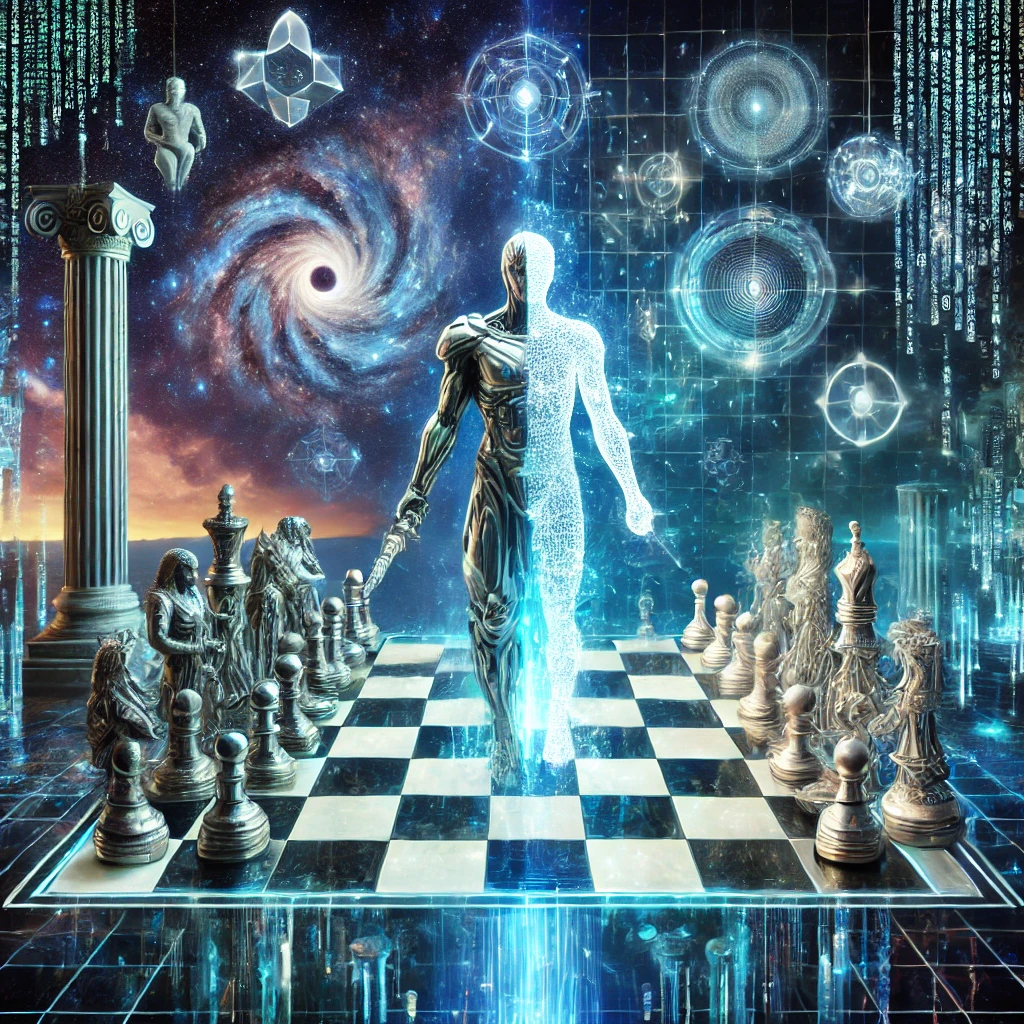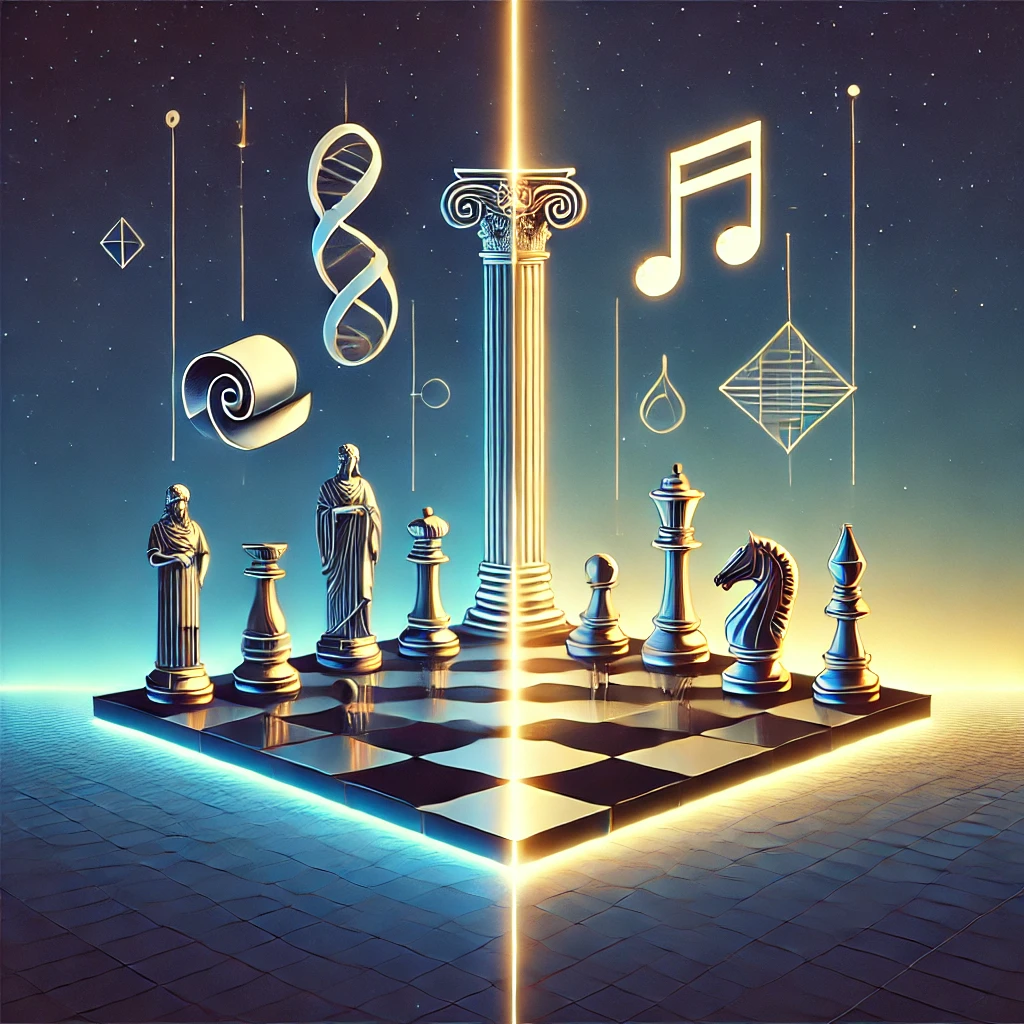
ChatGPT:
Homo Ludens by Johan Huizinga
“Homo Ludens” (1938) is a foundational text in cultural theory and anthropology, where Dutch historian Johan Huizinga explores the central role of play in shaping human civilization. He argues that play is not merely a leisure activity but a primary formative element in culture, law, war, art, and philosophy.
Conclusion (Spoilers)
Huizinga concludes that play is a core condition of human culture, not just a byproduct of civilization. Through examining ancient rituals, legal systems, art, and contests, he shows that these cultural structures evolve from “play-forms.” Even serious activities like war and justice retain aspects of play—competition, rules, dramatization, and symbolic value. Importantly, Huizinga laments the modern age’s diminishing sense of sacred play, especially under totalitarian and technocratic pressures. In his view, modern civilization risks degenerating because it forgets the intrinsic value of play as a creative, ethical, and liberating force.
Key points
🎭 Play precedes culture: Huizinga asserts that play is older than culture itself and is present in animals, suggesting its biological roots.
⚖️ Law originates in play: Ancient trials, rituals, and justice systems were stylized and symbolic—fundamentally playful in their enactment.
⚔️ War and competition are play-forms: Tournaments, sports, and ritualized combat reflect how society organizes conflict under game-like rules.
🎨 Art evolves from play: Aesthetic creativity, poetic meter, and dramatic representation are play-based structures in cultural expression.
⛪ Religious ritual is play: Sacred ceremonies follow formal rules, roles, and stylized language, showing how play shapes spirituality.
🧠 Play is voluntary yet rule-bound: A key trait is its duality—freedom with structure, fiction with seriousness.
❗ Play creates community: By forming “magic circles” (temporary, separate realities), play binds groups through shared experiences.
⏳ Modernity threatens play: Rationalization, industrialization, and propaganda degrade the spontaneous, sacred character of play.
☢️ Propaganda as corrupted play: Totalitarian ideologies weaponize play’s formal structures to control rather than liberate.
🧩 Play is ambiguous but vital: Though elusive to define strictly, its cultural function is undeniable and essential to human identity.
Summary
Homo Ludens: Ultimately, humans are not just “Homo Sapiens” (thinking man) but “Homo Ludens” (playing man)—play is how we build meaning and community.
What is Play?: Huizinga defines play as a voluntary activity, marked by tension, joy, and a sense of order. It is distinct from “real life” but deeply significant.
Play in Animals: He begins by showing that play is not exclusive to humans. Animals also engage in play behaviors—evidence of its biological basis.
Play and Culture: Contrary to popular belief, play doesn’t emerge from culture. Huizinga argues it’s the reverse—culture arises from play.
Play in Law and War: Early forms of law and justice were performative and playful—public duels, symbolic gestures, and formal recitations.
*****
Let’s unpack Huizinga’s core insight—that human culture is fundamentally ludic (play-based)—and how this insight has become even more relevant in the digital age, across several domains.
1. Gaming as a Dominant Cultural Force
Huizinga viewed play as the foundation of culture—voluntary, rule-based, creative interaction that gives rise to law, art, religion, and identity. In the 21st century, digital games have become a central cultural form, reinforcing his thesis.
- Video games are not just entertainment; they are platforms for storytelling, competition, community, and creativity.
- Games like Minecraft, Fortnite, and The Legend of Zelda provide virtual arenas—“magic circles”—where rules differ from real life, much like religious rituals or ancient mythic plays.
- The global gaming industry now rivals film and sports in revenue and reach, showing that play has not diminished—it has evolved technologically.
2. Role-play and Identity Formation
Role-playing was key to Huizinga’s theory—assuming roles in symbolic situations (ritual, trial, drama). Today, digital identities are inherently ludic:
- Avatars in MMORPGs (World of Warcraft, Second Life) allow users to construct and explore alternative selves.
- On social media, users engage in curated self-performance, choosing usernames, aesthetics, and personas. Platforms like Instagram or TikTok can be understood as performance stages.
- Cosplay, fandoms, and LARPing (Live Action Role Play) demonstrate how people use fictional frameworks to interact socially and build meaning.
3. Education through Game-Based Learning
Huizinga’s view that knowledge evolves from play is reflected in today’s game-based learning systems:
- Educational apps and platforms (e.g. Duolingo, Kahoot, Quizlet) use gamification—points, badges, leaderboards—to increase engagement.
- Simulation tools (e.g., flight simulators, VR surgery training) mimic ludic structures to teach complex skills in immersive, safe environments.
- Gamification of learning emphasizes how structured play helps people absorb rules, roles, and consequences, exactly as Huizinga argued for legal and philosophical development.
4. Politics as Performative Play
Huizinga worried about the corruption of play through propaganda and spectacle. In the digital age, his warning seems prophetic:
- Political campaigns now often resemble reality TV or video games—with scoreboards (polls), avatars (candidates), and fan bases (supporters).
- The “meme-ification” of politics—using humor, satire, and image remixing—reduces complex issues to playful signifiers.
- Platforms like Twitter or Reddit often host “debate games,” where users gain points (likes, karma) for wit or ideological alignment, not always for truth.
5. Virtual Worlds and the Metaverse
The rise of virtual worlds aligns with Huizinga’s idea of the “magic circle”—a separate, rule-bound reality for play:
- Roblox, Meta Horizon Worlds, Decentraland, and similar platforms allow users to build, explore, and transact in virtual economies.
- These digital environments blur lines between game, work, and social life.
- Concepts like the metaverse illustrate how society is moving toward persistent ludic spaces where play, commerce, and identity merge.
6. Digital Rituals and Sacred Play
Religion in Huizinga’s theory is a high form of sacred play. Digital spirituality now reflects this:
- Meditation apps and virtual prayer spaces create ritualistic experiences using sounds, visuals, and prompts.
- Online communities form sacred-like bonds through shared language, ceremonies (e.g. livestream events, digital vigils), and moral codes.
- The game-like mechanics of these platforms (streaks, rewards, levels) echo the structure of traditional rituals.
7. Creativity and User-Generated Culture
Digital platforms empower users to create within pre-defined ludic systems:
- TikTok and YouTube challenges, remix culture, and fan fiction all follow community “rules” while enabling infinite variation—hallmarks of play.
- Game mods, skins, and virtual goods in games like Fortnite or Counter-Strike form new economies and aesthetics entirely born from play.
8. Risks and Dangers of Digital Play
Huizinga cautioned that play could be corrupted by force, propaganda, or utilitarianism. Today’s concerns echo this:
- Addictive design exploits the reward systems of games and social media, turning free play into compulsion.
- Surveillance capitalism converts playful interaction into data and profit.
- Toxic play—trolling, griefing, harassment in games—mirrors how sacred play can degenerate into mockery or abuse.
Conclusion: Huizinga Reimagined for Today
Huizinga’s vision of Homo Ludens—the playing human—as central to culture has not only stood the test of time; it has gained new dimensions in the digital age.
Where once ritual and drama provided the structure of play, now code, servers, and interfaces do the same. The digital era hasn’t ended culture—it’s made culture more ludic, symbolic, and performative than ever.
Yet, Huizinga’s warning also holds: when play becomes coerced, commercialized, or loses its sacred quality, culture suffers. The challenge today is to protect the authenticity of play, not just in leisure but in politics, education, identity, and community.
Ritual and the Sacred: Religious rites are structured like games—symbolic, dramatic, and rule-governed, making the divine part of the ludic.
Language and Poetry: The origins of poetry, rhyme, and meter lie in linguistic play. Artistic form stems from the rules and repetition of games.
Play and Philosophy: Philosophical debate and rhetoric also reflect ludic structures—structured conflict through words and logic.
Degeneration of Play: In the modern world, Huizinga sees a loss of genuine play in favor of profit, efficiency, and control.
Play vs. Seriousness: True play exists alongside seriousness, not in opposition to it. Play can be grave, especially in rituals or legal proceedings.
*****
To protect the authenticity of play in a digital, commercialized, and hyper-rational world—as Johan Huizinga would advocate—we need strategies that preserve its voluntary, creative, symbolic, and sacred nature. Here are key methods, grounded in cultural theory, education, and digital ethics:
1. Restore Play as Voluntary and Non-Coercive
Why it matters: Play loses its essence when it becomes forced, addictive, or outcome-driven.
Methods:
- Design platforms and games with user autonomy in mind—no manipulative nudging (e.g. endless scroll, dark patterns).
- Prioritize open-ended play over achievement-focused gamification.
- Limit algorithmic pressure in social apps—allow users to engage on their own rhythms, not based on metrics.
2. Promote Play for Play’s Sake (Ludic Intrinsic Value)
Why it matters: Instrumentalizing play (for profit, propaganda, or efficiency) undermines its cultural depth.
Methods:
- Support non-commercial, indie games and artforms that focus on exploration, emotion, and experimentation.
- Encourage unstructured play in schools—beyond test prep or “serious games.”
- Create public digital spaces (like digital commons) that aren’t monetized or surveilled.
3. Re-sacralize Play with Meaningful Rituals
Why it matters: Huizinga saw rituals, festivals, and theater as the high form of sacred play. We’ve lost many such shared symbolic experiences.
Methods:
- Develop community-driven digital rituals—seasonal events, communal storytelling, shared ceremonies.
- Use art and narrative to imbue virtual experiences with symbolism (e.g. grief rituals in games like Journey, That Dragon, Cancer).
- Encourage local cultural festivals that integrate digital and physical play without commercial overreach.
4. Educate about Play Literacy
Why it matters: Many don’t recognize the difference between real play and gamified manipulation.
Methods:
- Teach media and play literacy in schools: how games work, how they affect emotions, and how to use them reflectively.
- Empower parents and educators to see play as essential to development, not a distraction.
- Promote understanding of the ethics of game design in tech education.
5. Limit Over-Gamification and Data Exploitation
Why it matters: Gamification turns everything into performance and competition, often to extract data or productivity.
Methods:
- Audit and regulate the use of gamification in workplaces, education, and health to avoid coercive dynamics.
- Ban exploitative practices like loot boxes and pay-to-win mechanics aimed at vulnerable users.
- Advocate for privacy-by-design in apps and games, especially those targeting children.
6. Preserve “Magic Circles” Free from Surveillance
Why it matters: The “magic circle” is a space where ordinary rules don’t apply. Surveillance destroys that imaginative freedom.
Methods:
- Create anonymity-friendly play spaces online (sandbox environments, offline modes).
- Use end-to-end encryption in play-related messaging or creativity tools.
- Resist the quantification of all play (e.g. fitness trackers, productivity apps turning life into points).
7. Support Community-Based Play Culture
Why it matters: Authentic play emerges within trusted, expressive communities, not mass markets.
Methods:
- Fund local makerspaces, hacker groups, and DIY game designers.
- Facilitate collaborative storytelling projects, fan fiction circles, and online co-creation.
- Encourage cooperative over competitive models (e.g. shared world-building games vs. zero-sum contests).
8. Acknowledge Emotional and Spiritual Dimensions of Play
Why it matters: Deep, emotional, or sacred play heals, teaches, and binds communities—Huizinga saw this as its highest form.
Methods:
- Promote therapeutic and healing play (e.g. sandbox therapy, VR empathy simulators).
- Integrate artistic, mythic, or symbolic content into game design and education.
- Respect ritualistic time-outs—non-digital sabbaths, communal fasting from screens, silent reflection spaces.
Conclusion: From Game to Grace
To protect the authenticity of play, society must go beyond just making games “fun” or “fair.” We must reclaim play as a creative, ethical, and sacred force, capable of building community, healing trauma, and making sense of chaos.
Play is not a luxury—it is the foundation of culture, identity, and imagination. As digital worlds continue to expand, our responsibility is to design and defend spaces where true play can flourish.

